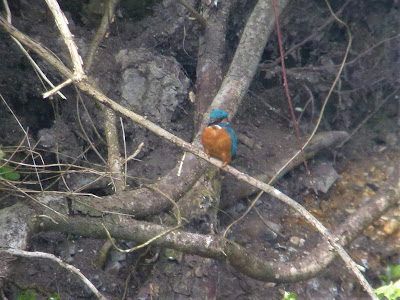This
was an extra guided walk to mark my birthday, and what better way to spend the
morning than with a group of Honeyguiders on my local patch? A lazy option for
me, as NWT’s Thorpe Marshes nature reserve is within easy walking distance, though
still only occasionally visited by most of today’s group. A whitethroat on a
dead branch in the field by Whitlingham Lane, the approach to the reserve, was
a good start.
It was one of the chillier days this cold and dry April, but that didn’t stop the activity approaching the peak time for bird song. Right by the railway bridge that is the reserve’s entrance was a willow warbler and a Cetti’s warbler that was clearly on view: so often they are noisy yet hidden. A sedge warbler sang noisily from a buddleia that hadn’t been pollarded.
We spent a little time at the first corner looking at the egg-laying scars of willow emerald damselflies on thin willow branches over the open water. Then a little farther along the permissive path through the ungrazed marsh we stopped by a nice clump of lady’s smock. On this we looked at two tiny eggs stuck under flower buds: from orange tip butterflies on a favoured larval food plant. See if you can see one in the photo below.
 |
| Lady's smock, and hunt the orange tip egg. |
Reed buntings and more sedge warblers kept us company, and there was a surprise in the eastern part of the open area of the marsh: two stonechats, a male and a female. These are a regular winter feature of Thorpe Marshes, as on other Broadland marshes, but to be still here in late April remains a puzzle. Somewhere in the big sedge beds a grasshopper warbler reeled, but only briefly and not everyone could hear it. Blackcap and chiffchaff in the wooded corner took us to seven warbler species seen or heard.
St Andrews Broad, the gravel pit, still had winter birds, namely tufted ducks and 110 black-headed gulls, though no longer a little gull – a remarkable 24 days with one or more of these unusual and charming birds here had ended on Saturday, two days ago. Common terns buzzed around, with five coming past. Swallows and house martins were nice then another surprise: a group of 15 of high-flying swifts. For a bird that we expect at the end of the first week of May it was quite something, though the Yare Valley is an area where early arrivals often appear in late April.
Heading back along the bank of the River Yare, we paused to try to get a better view of a kingfisher perching by the opposite bank. That was the female, then the male arrived. Then they mated and straight away he took several quick dives into the water: like a quick shower, it was suggested, or perhaps a celebratory plunge.
 |
| Kingfisher. The digiscoped photo doesn't do it justice, though no doubting the ID. |
Compared with mating kingfishers the various botanical observations on the home leg seem rather humdrum, though the yellow blisters peculiar to the leaves of alexanders are worth noting, galls caused by a rust fungus Puccinia smyrnii.
 |
| Galls on leaf of alexanders, caused by a rust fungus. |
Then there was coffee, lunch in the garden and birthday cake, courtesy of Ann. And over-flying buzzards, much closer than one in the distance this morning.
The walk raised £100 that was donated to Norfolk Wildlife Trust.
Chris Durdin




No comments:
Post a Comment